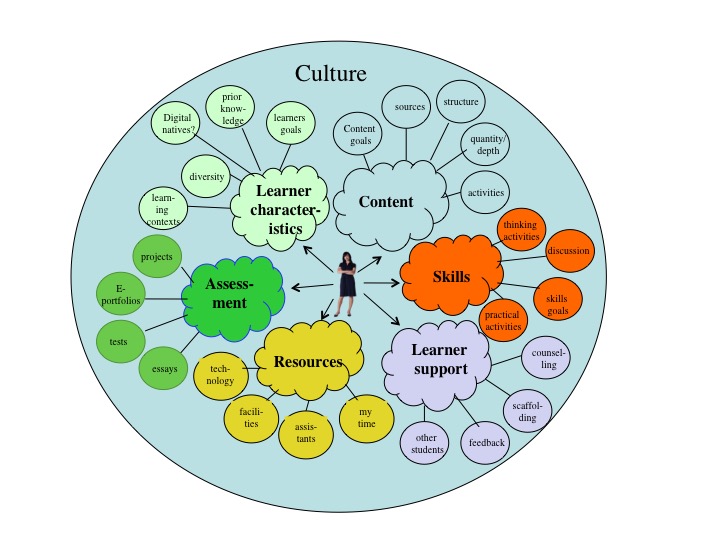Appendix 1: Building an effective learning environment
A.10 Building the foundation of good design
![]()

I have walked you through one possible learning environment. It is meant to be an example, not a recommendation. It probably fits a post-secondary educational context better than a school context. For instance, in a school context, play and parents may be two other important components, again depending on your underlying epistemology and beliefs about teaching and learning.
A.10.1 Epistemology and learning environments
We all come from different epistemological and philosophical positions about teaching and learning. This can be illustrated by two different metaphors. Some people see teaching and learning very much like the mining and transportation of coal. Knowledge is coal; it has to be mined (research) and then loaded and delivered (teaching). Learners are seen as buckets or railway wagons into which knowledge is delivered. Instructors are the shovels. In this process, learners are relatively passive in the sense that they do not transform the knowledge into something different. It is what it is.

Even though I come from a coal mining family on my mother’s side and a railway family on my father’s, I see teaching and learning differently. I see it more as a garden, with learners as the plants. Thus a gardener tries their best to create an ecological environment where plants grow and develop, by ensuring that they have the right balance of light, soil, water, and that they are not damaged by weeds or insects. I see learning as development and growth in individuals. My job as a teacher is to provide the best possible environment in which learners can grow and develop.

Similarly, teachers and instructors need to conceive and put in place a learning environment where students can grow and develop their own learning. Knowledge is not static, but grows and develops in learners. In particular, in a digital age, learning means developing skills as well as accumulating content. Thus the learning environment I have described reflects my more constructivist and ‘nurturing’ approach to teaching.
Even if you come from a different epistemological position though and see knowledge and learning in a different way, or are teaching in a very different context from post-secondary education, it still helps to look at all the components that need to be considered for effective learning, and how those should be configured. It is also worth remembering that in a digital age, our learning environment is no longer bounded by bricks and mortar. Technology allows us to create different and more flexible environments for encouraging learning.
A.10.2 Necessary but not sufficient
Thus as a teacher or instructor, you are in a better position to think about how you are going to design and implement a course or program if you already have in mind all the necessary components of a learning environment, taking into account new learning needs, changing learner characteristics, and the new technologies now available. The components of a learning environment provide a kind of check list in terms of what has to be considered when designing and delivering a program. Analysing all the necessary components that go to make an effective learning environment provides you with a strong foundation around which to design your teaching.
It should be noted though that even once the main components have been identified, you will still need to make many decisions about how those components will be designed and delivered. Even with such a strong conceptual foundation, you still have to implement it; in other words, you still have to design your teaching.
Activity A.10 Designing your own learning environment
- Describe the current learning environment in which you are teaching a particular course or program.
- What are the main components to which you give the most attention?
- Would you make changes to that learning environment as a result of reading this chapter? Why?
- Now: can you design a learning environment that will best fit the needs of the course and your students? To do this you will need to:
- Decide on the key main components and their sub-components
- Make choices or decisions for each of the sub-components.

